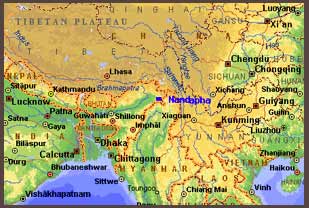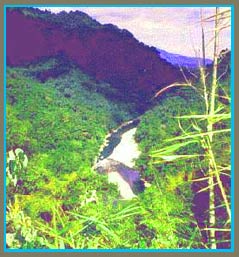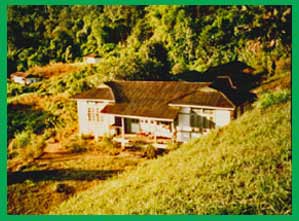|
Travelogues Namdapha: Forgotten Rain Forest
|
|||||||||
"Country roads take me home
to the place I belong" ~ John Denver Rainforest? Namdapha National Park? Arunachal Pradesh? Northeast? These were a few questions, which raced through my mind when I decided to join a group in Bombay for a trip to Namdapha National Park in Arunachal Pradesh. 'Rainforest', a term coined in 1898 by a German botanist named Schimper, conjured images of a seemingly impenetrable jungle, dark, oppressively hot and humid with a profusion of hanging vines and creepers concealing animal life. I was in for many surprises. Rainforests are tangled with a multitude of plant and animal life, astonishing to the newcomer. |
More on North East • Arunachal Pradesh • Assam
Travelogues
Wildlife
Environment | ||||||||
Namdapha is located in the Changlang district, which forms the Western boundary of the park. To the Southeast, are the hills and the forest of Myanmar and to the North lie the mountains of Dapha Bum range. They form the barrier between Namdapha and the Lohit basin.
 We reached Miao at about 2:30 p.m in the afternoon. We were greeted with the news that one of the jeeps was dysfunctional, and we would have to wait to reach the guesthouse in the park, which is only accessible, by jeep. We decided to trek the 25 kilometers to our destination. The forest welcomed us with uprooted banana trees and fresh droppings of elephants, and the continuous shrill sound of crickets. The surrounding beauty was awesome. I remembered Charles Darwin's "Delight is a weak term to express the feelings of a naturalist who for the first time, has wandered by himself in a rainforest".
We reached Miao at about 2:30 p.m in the afternoon. We were greeted with the news that one of the jeeps was dysfunctional, and we would have to wait to reach the guesthouse in the park, which is only accessible, by jeep. We decided to trek the 25 kilometers to our destination. The forest welcomed us with uprooted banana trees and fresh droppings of elephants, and the continuous shrill sound of crickets. The surrounding beauty was awesome. I remembered Charles Darwin's "Delight is a weak term to express the feelings of a naturalist who for the first time, has wandered by himself in a rainforest".
We walked in silence till we decided to stop beside a little pond to rest our tired legs, and soon learnt what leeches are all about. We did declare war on the leeches but soon realized that we had encroached on their habitat and not them on us. We finally reached the last of civilization at Deban at 10 at night. The forest lodge was on a thickly wooded hill slope. At 4:30 in the morning, by sheer will power we woke to set off for an early morning hike. Initially, Namdhapha appeared to be strangely devoid of animals although we could hear the whistles, chirps and yelps of birds through the canopy of leaves above.
The forest was literally teeming with gibbons - the only ape species in India. We could hear them but the dense forests hid them well. Suddenly I noticed a pair of gibbons sitting high on a tree with a baby clinging to its mother's belly, chewing on the semi transparent new leaves. Both the male and the female varied in colour from brownish black to yellow grey. Baby gibbons are pale greyish white with slight yellow streaks. While the mother gibbon swung from one tree to the other covering large distances, the young gibbon clung to her. Apparently, they spend the greater part of the day in high trees but during the hottest part of the day they descend to the lower trees. They appeared to be gentle and good natured, but sensitive and shy. Their faces seemed strangely expressive as though they were communicating with us. One of them wore the very same intellectual expression of a college professor of mine.
On the pebbled river bank of the Namdapha were a few white egrets along with a couple of black cormorants, sitting motionlessly awaiting their prey. The silence of the forest was broken by the sudden appearance of langurs as they darted from one tree to another. Namdapha is home to tigers, leopards and fishing cats. Our attention was drawn to a large variety of spiders of different shapes, colors and sizes. It was fascinating to watch them weave a web, as the early morning sun warmed us.
Two hundred kms from Deban is a small hamlet called Vijaynagar. A succession of earthquakes, landslides and rains have made it inaccessible except on foot. Vijaynagar is inhabited by the Lisu tribe, which hunt forest animals. This has caused some friction between them and the forest officials. They can sometimes be seen in Miao town shopping and loading provisions on asses and donkeys before heading back home to Vijaynagar. In the evening we sat beside a fire and were served Rice beer, the popular local drink. The sight of the huge yellow moon, whose glow surrounded the valley, overwhelmed me. The crickets with their raucous calls and the occasional cry of the barking deer further enhanced the surreal quality of my surroundings. We decided to turn in early as we had a long day ahead of us. We had decided to trek to Hornbill glade, which was about 20 kilometers from Deban valley. We hired a guide and a boatman who ferried us across the Noa Dihing River. We could see a couple of hornbills flying high and gliding with upturned wing tips as they seemingly protested against the trespassers in their territory. According to our guide the female confines herself to the hollow of a tree during the nesting and breeding season. The opening of the hollow is gradually walled by her own droppings after she settles herself inside and lays eggs there. A small opening is however, left on the wall of the nest through which the male continues to feed her during her exile. The female comes out of the hollow after the eggs are hatched. I thought this reflected a great sense of joint responsibility. Namdapha is also home to the oldest tree. We had barely covered half the distance when heavy rains made the path slippery and dangerous. We finally managed covered the 13 km distance having slipped many times en route. On the way we came across tracks left by wild elephants. Their large footprints made nice little puddles of water. We camped next to the river for the night. A tiger had been spotted near the Noa Dhing River and rumour had it that it visited the area around 2 every night. Excited at the prospect of seeing a tiger we camped outside, but the day's excitement and tiredness began to take its toll. Before long we were asleep lulled by the occasional sound of the owl. We woke at 7.00 in the morning with the previous day's adventure still fresh in our minds. We voted to visit the Chakma tribe, refugees from Bangladesh who have made a small village in Deban. When we packed our bags to bid goodbye to Namdapha, I could not leave without taking a reminder of my visit. I took a leech. Someone once told me that a leech has a long life...
|
|||||||||
Editor: Romola Butalia (c) India Travelogue. All rights reserved. |
|||||||||


 Namdapha is a veritable butterfly and bird paradise. I could identify the Fluffy Tit and brilliant Purple Sapphire as well as the Golden Babbler, Great Slaty Woodpecker, Great Hornbill and Grey Peacock Pheasant. We could see Bluebearded Bee-eaters and Green Magpies fluttering and flapping around the forest rest house.
Namdapha is a veritable butterfly and bird paradise. I could identify the Fluffy Tit and brilliant Purple Sapphire as well as the Golden Babbler, Great Slaty Woodpecker, Great Hornbill and Grey Peacock Pheasant. We could see Bluebearded Bee-eaters and Green Magpies fluttering and flapping around the forest rest house.